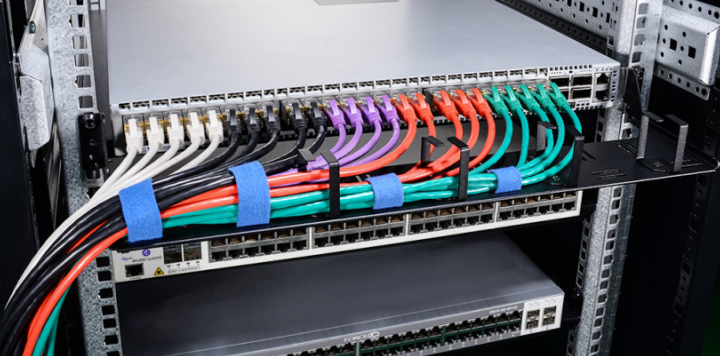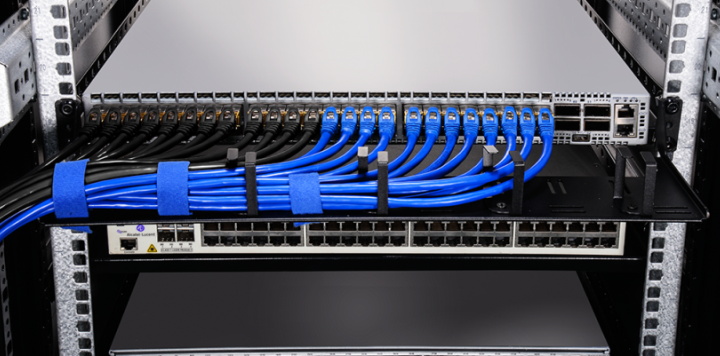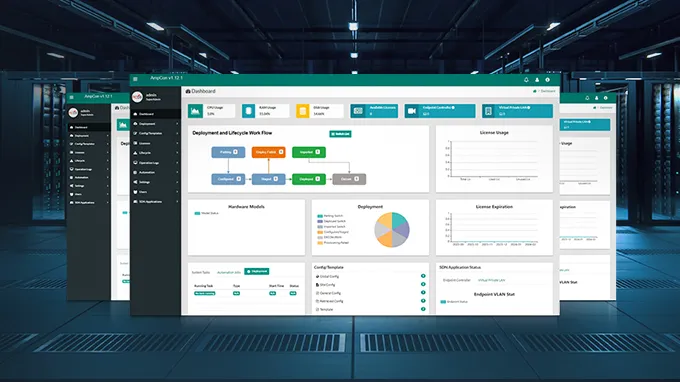Esecuzione di 10GBASE-T Su Cablaggio Cat6 vs Cat6a vs Cat7?
Le richieste di larghezza di banda elevata continuano ad aumentare. I cavi patch Cat5 e Cat5e non sono più adatti a 10Gbps, il che richiede nuove specifiche per il cablaggio in rame a doppino. Per le applicazioni ad alta velocità di 10GBASE-T sono stati introdotti cavi Ethernet con una maggiore larghezza di banda, come i cavi Cat6, Cat6a e Cat7. Quali sono le differenze tra i cavi Cat6, Cat6a e Cat7? Dovrei scegliere Cat7, Cat6 o Cat6a come cavi Ethernet 10G?
Breve Introduzione a Cat6 vs Cat6a vs Cat7
In parole povere, le specifiche del doppino: Cat6 (Classe E), Cat6a (Classe EA) e Cat7 (Classe F) supportano tutti applicazioni 10GBASE-T con prestazioni differenziate.
Per una comprensione completa delle specifiche e delle applicazioni tipiche di Cat6 vs Cat6a vs Cat7, consultare la tabella seguente.
| Cat6 | Cat6a | Cat7 | ||
|---|---|---|---|---|
| Specifiche | Frequenza | 250MHz | 500MHz | 600MHz |
| Trasmissione di Dati | 1000 BASE-T e Massimo a 10GBase-T | 10GBASE-T | Superiore a 10GBASE-T | |
| Tipo di Connettore | RJ45 (per Cat6) | RJ45 (per Cat6a) | GG45 | |
| Schermatura | UTP o STP | UTP o STP | SOLO Schermato | |
| Usi Comuni | Linee Telefoniche | √ | × | × |
| Rete Domestica | √ | × | × | |
| Rete Aziendale | √ | √ | × | |
| Data Center | × | √ | √ |
-
Cat6 supporta gli standard 10BASE-T, 100BASE-TX, 1000BASE-T e 10GBASE-T, frequenze fino a 250 MHz e può gestire fino a 10 Gbps in condizioni di throughput con una lunghezza massima del cavo di 55 metri.
-
Cat6a è una proposta di 10 Gigabit Ethernet su rame allo standard Cat6. Il cavo Cat6a è progettato per supportare frequenze fino a 500 MHz, il doppio rispetto a Cat6, che può supportare fino a 100 metri per la trasmissione di 10Gbps.
-
Che cos'è il Cat7? Il cavo Cat7 supporta frequenze di trasmissione fino a 600 MHz. Supporta 10GBASE-T Ethernet su 100 metri, con una migliore riduzione del rumore di diafonia.
Nota:
TUTTE le compatibilità con il passato: è possibile collegare un cavo a doppino più recente a un dispositivo progettato per un cavo più lento.
Il cavo Ethernet più veloce è Cat8, che può supportare una velocità di trasferimento dati fino a 40 Gbps, quattro volte superiore a quella del cavo Cat6a. Se siete alla ricerca di un cablaggio ad alta velocità per data center e sale server, date un'occhiata a Cavo Cat8 per Rete 25G/40GBASE-T.
Cat6 vs Cat6a, Come Scegliere?
In generale, il cavo 10GbE Cat6a offre prestazioni di rete migliori rispetto al cavo 10GbE Cat6. Il cablaggio Cat6a 10GBASE-T è in grado di fornire prestazioni 10G a frequenze più elevate (500 MHz) e con lunghezze di collegamento maggiori (100 m) rispetto al cablaggio Cat6 (250 MHz, 55 m). Il cavo Ethernet Cat6 supporta 10GBASE-T solo su una distanza compresa tra 37 e 55 metri, a seconda dell'ambiente di diafonia alieno.
Rispetto al Cat6, il Ca6a ha una guaina più robusta, che riduce la diafonia aliena e migliora il rapporto segnale/rumore. Inoltre, l'adozione di un cavo Cat6 a 10Gbps non consente di utilizzare la modalità di risparmio energetico a corto raggio. La modalità a corto raggio può ridurre il consumo energetico di 1W per porta quando si utilizza un cavo Cat6 di 30 metri o meno. Pertanto, il cavo Cat6 da 10GBASE-T non è sufficientemente conveniente e rispettoso dell'ambiente per le applicazioni 10GBASE-T. Inoltre, il cavo Cat6 non è in grado di dissipare il calore come il cavo Cat6a 10GBASE-T, poiché il cavo Cat6 10GBASE-T ha un conduttore di diametro inferiore.
10GbE su Cavi Cat6 o Cat6a
Il cablaggio 10GbE Cat6 costa effettivamente meno del cablaggio 10GbE Cat6a. Tuttavia, se si azzarda l'esecuzione di 10Gbps su un cablaggio Cat6, si dovranno sostituire tutti i componenti Cat6 quando non funzionano, il che costerà molto di più rispetto all'uso diretto di un cablaggio Cat6a.
In una parola, il cavo 10GBASE-T Cat6 vs Cat6a, il primo non è consigliato per alcune applicazioni 10GBASE-T a causa delle sue limitazioni. Il grado minimo di cablaggio da impiegare in una rete 10GBASE-T dovrebbe essere il cavo Cat6a. Per quanto riguarda il tipo di cavo Cat6a 10GBASE-T da utilizzare, si può fare riferimento a Come Scegliere il Giusto Cavo Cat6a per le Reti 10G.
Cat6a vs Cat7, Come Scegliere?
In realtà, lo standard Cat7 è stato ratificato per supportare 10Gbps su 100 m prima del Cat6a. Uno dei principali vantaggi del cavo Cat7 è la presenza di una schermatura per ciascuna delle quattro coppie di fili e per l'insieme delle quattro coppie, che lo rende più resistente ai disturbi ma anche meno flessibile e maneggevole. Pertanto, il cavo 10GbE su Cat7 è meno facile da installare rispetto al cavo Cat6a, mentre il prezzo del cavo Cat7 è molto più elevato.
In laboratorio, la velocità del cavo Cat7 ha dimostrato di poter raggiungere velocità di trasferimento dati di 40Gbps, 50Gbps e 100Gbps. Ma il cavo Cat7 in sé fornisce solo la potenza e la velocità dell'apparecchiatura e del tipo di Internet con cui lavora. La velocità di Internet non migliorerà se si passa a un cavo più veloce ma si continua a utilizzare apparecchiature a velocità inferiore. In altre parole, se si utilizza uno switch in rame da 10GBASE-T per collegare il server a 10G, si otterrà al massimo una velocità di 10G sia che si sostituisca il Cat6a con il Cat7 sia che non lo si sostituisca.
10GbE su cavi Cat7
Il tipo di connettore per Cat7 è leggermente diverso dal precedente connettore GG45 compatibile con due RJ45. Sebbene il cavo Cat7 possa utilizzare anche un connettore RJ45, sarà più facile terminare questo cavo con una guaina spessa al jack stretto sul campo. Pertanto, potrebbe essere necessario assumere un elettricista specializzato o dedicare molto tempo alla terminazione dei jack RJ45 ai cavi Cat7.
Quindi, Cat7 o Cat6a, quale scegliere? La maggior parte delle persone ritiene che il Cat7 fornisca una larghezza di banda significativamente superiore a quella necessaria, optando quindi per il Cat6a o il Cat6. Tuttavia, man mano che un numero sempre maggiore di abitazioni aggiunge tecnologie aggiuntive ai propri cavi Ethernet, come l'automazione, i dispositivi di sicurezza a circuito chiuso, i server personali e la tecnologia smart home, il Cat7 potrebbe essere più appropriato. Per questo motivo, chi prevede un aumento dell'utilizzo della larghezza di banda può optare per il cavo più veloce Cat7, mentre chi aggiorna la tecnologia di rado può optare per il Cat6a, che è del tutto sufficiente.
Riflessioni Finali
Come decidere quale sistema di cablaggio strutturato utilizzare? Se installare Cat6, Cat6a o Cat7? Rispondete alle seguenti domande per capire:
-
Quali sono le applicazioni attualmente utilizzate?
-
Quali applicazioni future prevede la vostra organizzazione?
-
Qual è la durata prevista dell'edificio? 5, 10, 20 o addirittura 25 anni?
Qual è il budget o il costo previsto?
-
Quale crescita prevedete per la vostra rete nei prossimi cinque anni in termini di dati trasmessi e numero di utenti?
-
Quale sarà il costo della re-installazione di una nuova rete in grado di gestire le velocità future?
I cablaggi Ethernet standard Cat6, Cat6a o Cat 7 sono tutti disponibili per l'utilizzo nella rete in rame 10GBASE-T per massimizzare l'utilizzo del cablaggio strutturato in rame esistente. Per raggiungere il giusto equilibrio tra prestazioni e costi, Cat6a è il cavo preferito per 10GBASE-T Ethernet in Cat6 vs Cat6a vs Cat 7. A lungo termine, Cat6a è considerato la scelta ideale in quanto è considerato un sistema di cavi a prova di futuro.
Se non siete ancora sicuri del tipo di soluzione di cablaggio da scegliere, contattate il nostro account manager per una consulenza tecnica professionale.
Potresti essere interessato a
Indirizzo Email

-
Cosa è la porta SFP di uno switch Gigabit?
22 Mag 2023
-
Cosa è un Iniettore PoE e come si usa?
21 Feb 2023
-
DHCP o IP Statico: Qual è il migliore?
08 Mag 2023
-
Come Capire l'indirizzo IP e la Subnet Mask?
24 Set 2022
-
Come Collegare Più Switch Ethernet?
22 Set 2022















